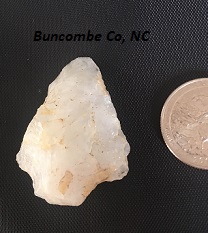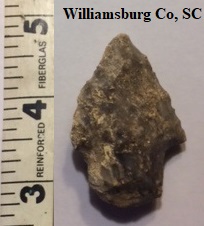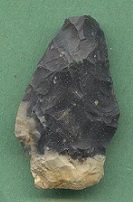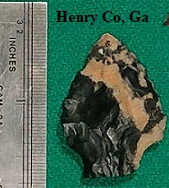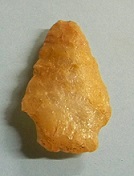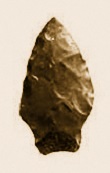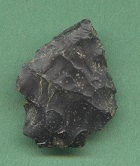Other Websites with Detailed Information:
Name Details:
Named By: Bennie C. Keel
Named For: Swannanoa River Valley, North Carolina
Date Identified: 1976
Type Site: Warren - Wilson Site, North Carolina
Swannanoa
Cluster:
Commonly Utilized Material:
Cherts, quartz, quartzite, and jasper
Date:
Cultural Period:
3,000 - 2,300 B.P.
Early Woodland
Neoglacial to Roman Warm
Glacial Period:
Culture:
Outline is Representative of Size and Shape:
Description of Physical Characteristics and Flaking Pattern:
This is a
thick small (1,25 to 2.5 inches) triangular stemmed point with an elliptical cross section. The blade is
broad and excurvate. The shoulders are at an upward angle and may vary from prominent to weak. The stem
is poorly defined but relatively large, short and is slightly contracting to
slightly expanding with a base that is most commonly straight, but may vary to slightly concave. This point has a random flaking pattern.
Size Measurements: Total Length - 21 to
63 mm (average 33 to 43 mm), Stem Length - 6 to 15 mm (average 8
to 11 mm), Blade Width - 10 to 33 mm (average 19 to 25 mm), Stem
Width at Shoulders - 9 to 23 mm (average 12 to 16 mm), Basal Width
- 10 to 19 mm (average 12 to 14 mm), Thickness - 6 to 15 mm
Distribution:
Distribution Comments:
This point is most commonly found in the Piedmont of North Carolina and South Carolina and into the Appalachian region. This point may be found into the Piedmont of Virginia and Georgia and Appalachian
region of Tennessee.
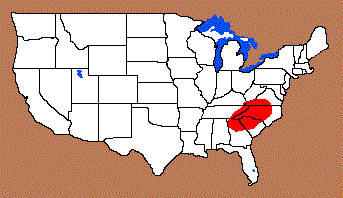
Additional Comments:
The Swannanoa Stemmed, Plott Short Stem, and Gypsy represent the last of the carry over stemmed type points from the Late Archaic period into the Woodland period in North Carolina (Ward and Davis, 1999).
Keel (1976) points out that this type is commonly found with Transylvania Triangular points which marks the introduction of bow and arrow technology.
This type can be difficult to distinguish from the Plott Short Stem points.
Cable et al. (1997) referred to these points Swannanoa/Plott Stemmed due to
the overlapping characteristics of the two types and the difficulty in
distinguishing Swannanoa points from Plott Stemmed type
Other points in this Cluster:
Point Validity: Valid Type
Keel is an anthropologist and
professor at the University of North Carolina – Chapel Hill. He is considered an expert on southeastern archaeology and is dedicated to archaeological preservation. He was awarded the Lifetime Achievement Award in 2012 by the Society of American Archaeology. This type was named in a his Ph.D dissertation and has many
professional references. This is considered a valid type.
.
Age Details:
Swannanoa points are part of the Early Woodland period with a temporal
estimate of 2,700 to 2,200 BP. The Gypsy Stemmed point (Oliver 1981) is
almost identical to the Swannanoa, but is considered an earlier type dating
around 3,200 B.P. Due to the somewhat nondescript nature and
overlapping characteristics of these types, it may be appropriate to lump
the two types together in a terminal Late Archaic to Early Woodland time
frame from 3,200 to 2,200 B.P. (Whatley, 2002)
References: (See Reference Page, Entry Number):
30, 162, W18
Swannanoa Projectile Point, Swannanoa Arrowhead



